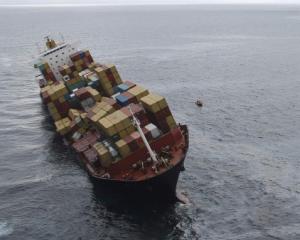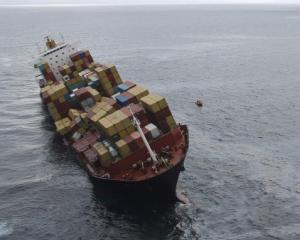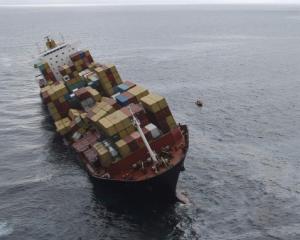The huge accommodation block of the wrecked container ship Rena is to be removed, in a major development revealed by the ship's owners and insurers today.
The decision to remove the four-storey block, which contained the Rena's crew quarters, galley, offices and bridge, has been made in advance of any move to apply for a resource consent to leave part of the ship on the seabed.
It follows concerns about the possibility the block would degrade or collapse at some time in the future and release debris that could wash up on the shoreline.
The operation, planned to start in August or September, would form another major step in a salvage operation that began when the ship grounded on Astrolabe Reef off the Tauranga coast on October 5, 2011, and has so far cost $300 million.
"Our environmental experts have not identified any environmentally harmful material in the accommodation block," said Captain John Owen of insurers The Swedish Club.
Any debris that might be released and eventually wash ashore would be picked up by the shoreline monitoring and clean-up process that had been put in place, he said.
"However, we understand that people do not want the uncertainty of not knowing when this might happen and how long it could go on for.
"Although there is a considerable cost to removing the accommodation section, we recognise the importance of minimising the effects on the community of the Rena grounding as much as we can.
"We appreciate that the accommodation section would have been of interest to recreational divers, and our initial approach was to consider leaving it as part of the wreck after making it safer for divers.
"However we could not tell how long it would stay in that condition before the effects of wave action and the strong currents caused it to deteriorate and become a hazard to their safety."
The accommodation block was relatively a much lighter structure than the hull and had no direct contact with Astrolabe Reef, therefore coming with just minimal risk of causing damage to the reef, the insurers said.
US salvors Resolve Salvage and Fire, which had been tasked with cutting the ship's bow to 1m below the shoreline, would remove the accommodation block in two sections by means of oblique chain cutting parallel to the main deck.
The operation is expected to take up to 80 days, including 40 days allowance for poor weather and sea conditions, and cutting was expected to begin in October following the arrival of an additional crane barge from Singapore.
Once each section is cut away, it will be lifted onto a third barge for transport to Port of Tauranga. Once in port, the sections would be dismantled for scrap and, where possible, recycling.
A team of smaller craft would be stationed at the reef to collect any debris released during the removal operation, to prevent material reaching the shore.
During the dismantling phase steps will be in place to prevent any discharges into the environment.
In the meantime, the salvors would continue with the work to reduce the bow section where the ship ran aground near the highest part of the reef.
All of the bow section that was above the water line has now been removed and the aim is to reduce it down to at least 1 metre below the lowest tide mark.
Resolve was also working to recover container wreckage and other cargo from the debris field between the stern and bow sections, of which 650 tonnes have already been removed.
Debris from cargo hold four was being removed to allow access to two containers of plastic beads originally at the bottom of that hold.
Both containers had been located, in a damaged condition; one has been emptied completely and the other container was being worked on.
Dive surveys of cargo holds five and six would then be conducted to locate and identify the state of four other containers of interest.
Bay of Plenty Regional Council chief executive Mary-Anne MacLeod said the removal of the accommodation block addressed concerns about the contents of the block escaping and how they would be dealt with.
"Its removal from the reef will greatly reduce the risk of further debris being released into the coastal environment."
- Jamie Morton of the New Zealand Herald





